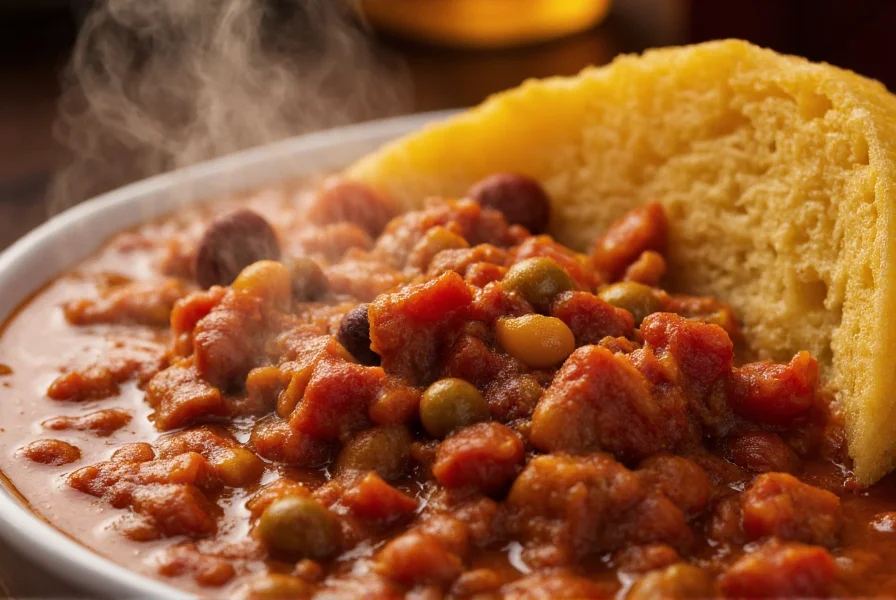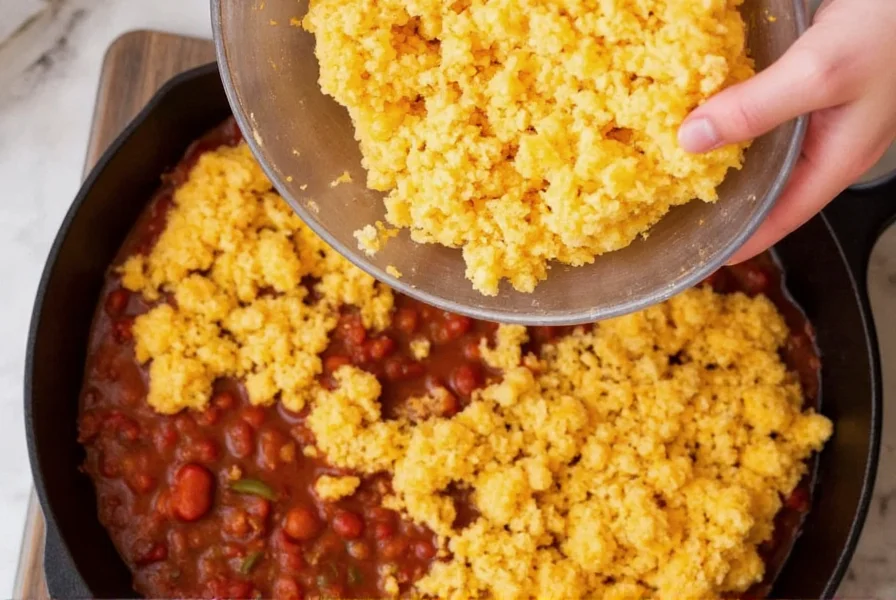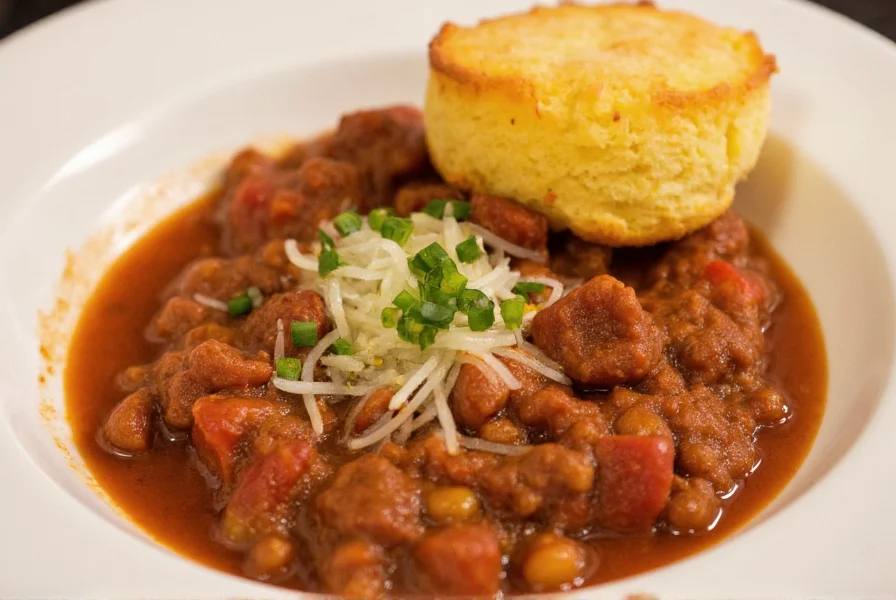Nothing satisfies like a steaming bowl of chili paired with a wedge of golden cornbread. This classic American comfort food combination delivers more than just hunger satisfaction—it represents a culinary harmony perfected over centuries. The sweet, slightly crumbly cornbread perfectly offsets chili's spicy, meaty richness while providing textural contrast that elevates both components. Understanding why this pairing works so well transforms a simple meal into a thoughtfully crafted dining experience.
The Science Behind the Perfect Flavor Pairing
Chili's capsaicin—the compound responsible for heat—binds to pain receptors in your mouth, creating that familiar burning sensation. Cornbread's natural sweetness and fat content provide immediate relief by dissolving and washing away capsaicin molecules. The cornmeal's coarse texture also creates physical barriers that prevent chili from directly contacting sensitive areas of your mouth.
Food scientists confirm that cornbread's pH level (typically between 6.0-6.5) helps neutralize chili's acidity from tomatoes and vinegar. This chemical balancing act makes each bite more palatable while allowing complex flavors to shine through without overwhelming heat. The Maillard reaction during cornbread baking creates hundreds of flavor compounds that complement chili's deep umami notes.

Historical Roots of This Iconic Pairing
This culinary marriage originated in the American Southwest where Native American, Mexican, and frontier cooking traditions converged. Indigenous peoples introduced corn-based breads while Spanish settlers brought chili peppers. By the 19th century, Texas cowboys combined these elements with available meats and beans to create portable, sustaining meals.
Historical records show that chuckwagon cooks perfected this pairing during cattle drives. Cornmeal traveled well without refrigeration, while chili could be kept warm for days. The combination provided complete nutrition—carbohydrates from cornbread, protein from chili's meat and beans, and essential vitamins from peppers and tomatoes.
| Regional Variation | Chili Characteristics | Cornbread Style |
|---|---|---|
| Texas Style | Meat-heavy, no beans, deep red | Savory, less sweet, cast iron baked |
| New Mexico Style | Green chili base, pork or venison | Blue cornmeal, slightly denser |
| Cincinnati Style | Spaghetti base, cinnamon notes | Sweeter, cake-like texture |
| Midwest Style | Bean-heavy, tomato-based | Buttermilk cornbread, muffin form |
Mastering the Perfect Serving Technique
Temperature matters significantly in the best cornbread to serve with chili. Serve chili piping hot (165-180°F) while cornbread should be warm but not scalding (140-150°F). This temperature differential creates a delightful sensory experience as the hot chili slightly melts the cornbread's surface.
For authentic southwestern comfort food pairing, crumble cornbread directly into the chili bowl rather than serving it on the side. This allows gradual integration as you eat, with each bite offering different ratios of components. Many Texans prefer using cornbread as an edible bowl—a technique requiring properly textured cornbread that holds its shape for 10-15 minutes.
The perfect cornbread texture for chili balances moisture and structure. Overly dry cornbread becomes unpleasantly crumbly, while too-moist cornbread disintegrates immediately. Aim for 20-25% moisture content—achieved by using buttermilk and letting cornbread rest 10 minutes after baking before serving.

Avoiding Common Pairing Mistakes
Many home cooks make critical errors that undermine this traditional chili and cornbread pairing. The most frequent mistake involves mismatched spice levels—serving extremely hot chili with overly sweet cornbread creates flavor confusion rather than balance. Adjust cornbread sweetness based on chili's heat level: for very spicy chili, reduce sugar by 25%.
Serving cornbread too far in advance causes moisture loss that ruins the chili cornbread flavor balance. Cornbread's optimal serving window is 20-45 minutes after baking. For meal prep, bake cornbread while chili simmers, covering it with a clean towel to retain moisture without creating sogginess.
Another overlooked factor is chili consistency. For proper how to serve cornbread with chili technique, chili should have a thick, stew-like texture that clings to cornbread without immediately saturating it. If your chili is too thin, simmer uncovered for 10-15 minutes before serving to concentrate flavors and improve texture.
Modern Interpretations While Honoring Tradition
Contemporary chefs honor this authentic texas chili cornbread tradition while introducing thoughtful innovations. Adding roasted corn kernels to cornbread enhances texture contrast with chili. Some bakers incorporate a small amount of masa harina (20% of total cornmeal) for deeper corn flavor that complements traditional chili spices.
For those exploring make-ahead cornbread for chili, consider preparing cornbread muffins the night before. Store cooled muffins in an airtight container, then reheat in a 325°F oven for 8-10 minutes before serving. This method preserves texture better than reheating a whole cornbread loaf.
Frequently Asked Questions
What makes cornbread the perfect accompaniment to chili?
Cornbread's natural sweetness balances chili's heat while its fat content dissolves capsaicin compounds. The slightly crumbly texture provides contrast to chili's chunky consistency, and cornbread's pH level helps neutralize chili's acidity, creating a harmonious flavor profile that satisfies multiple taste receptors simultaneously.
Should cornbread be served on the side or crumbled into the chili?
Traditional Southwestern and Texan serving methods prefer crumbled cornbread directly in the chili bowl. This allows gradual integration as you eat, with each bite offering different ratios of components. Some Texans even use cornbread as an edible bowl, which requires properly textured cornbread that maintains structure for 10-15 minutes when exposed to hot chili.
How can I adjust cornbread sweetness based on my chili's heat level?
For extremely spicy chili, reduce cornbread sugar by 25% to avoid flavor confusion. Medium-heat chili pairs well with standard cornbread sweetness (1/4 cup sugar per batch). Mild chili benefits from slightly sweeter cornbread (add 1-2 tablespoons extra sugar) to enhance the overall flavor balance without overwhelming the palate.
What's the ideal temperature for serving chili with cornbread?
Serve chili piping hot at 165-180°F while cornbread should be warm but not scalding at 140-150°F. This temperature differential creates a delightful sensory experience as the hot chili slightly melts the cornbread's surface. Never serve cornbread at room temperature with hot chili, as the texture contrast disappears and the pairing becomes less satisfying.











 浙公网安备
33010002000092号
浙公网安备
33010002000092号 浙B2-20120091-4
浙B2-20120091-4